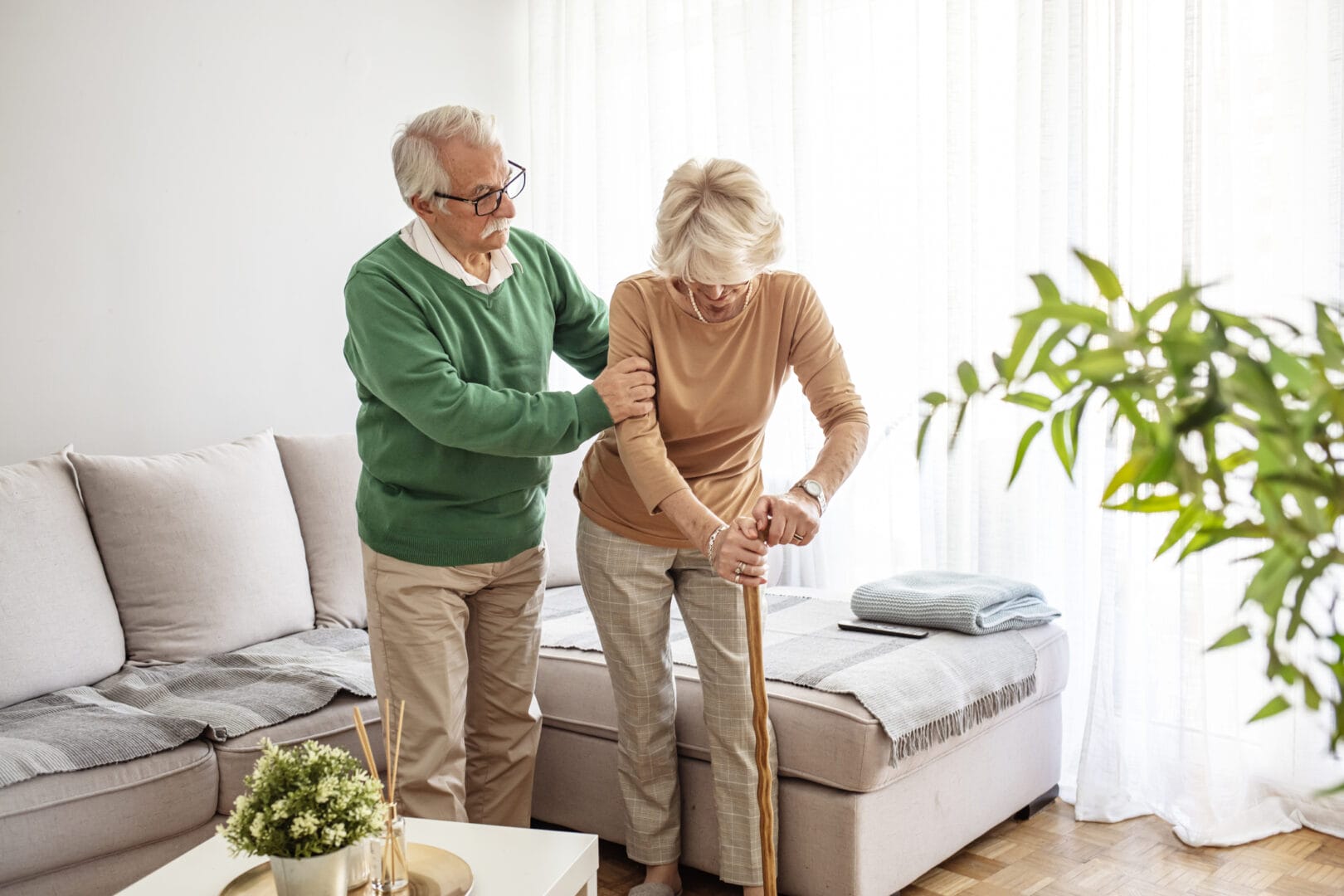In the everyday lives of seniors battling arthritis, the home can quickly turn from a sanctuary to a place filled with obstacles. Simple tasks like reaching for items or going upstairs become daunting challenges, which can lead to frustration and a sense of reliance on others. However, there's hope on the horizon through the idea of home modifications for seniors with arthritis.
By making strategic changes to reduce strain, boost safety measures, and make moving around easier, we can empower our senior loved ones on their arthritis journey. Our aim is to create a space where they can move confidently, regain a sense of independence, and ultimately enhance their quality of life.
Understanding Arthritis and its Impact on Mobility in Seniors
Arthritis, a common chronic condition among seniors, encompasses various joint disorders characterized by inflammation and pain. It significantly affects mobility and dexterity by causing stiffness, swelling, and reduced range of motion in the joints. These physical limitations make everyday tasks like walking, standing, or using hands challenging and sometimes excruciating.
Around the home, seniors with arthritis face numerous challenges. Difficulty gripping objects, such as utensils, doorknobs, or pens, can hinder daily activities. Bending down to pick up items or reaching for objects on high shelves becomes problematic due to joint stiffness and pain, leading to frustration and dependency. Basic household chores like cleaning, cooking, or getting dressed pose significant hurdles. Moreover, navigating narrow doorways or cramped spaces exacerbates mobility issues, further complicating daily routines for seniors with arthritis, which caregivers should be mindful of.
Arthritis isn't just about sore joints. It's about the constant battle to keep moving.
Helen Mirren
Key Areas of Home Modification for Seniors
1. Kitchen Modifications
In the kitchen, implementing modifications tailored to the needs of seniors with arthritis can significantly improve their comfort and independence. Here are some essential adjustments to consider:
- Adaptive Tools: Installing lever-style faucet handles, automatic soap dispensers, and easy-to-grip cabinet pulls can make daily tasks much easier for those with arthritis. These adaptive tools require less dexterity and strength to operate, reducing strain on the joints and making tasks like washing dishes and opening cabinets more manageable.
- Workstation Height: Adjusting the height of workstations can help seniors avoid strain from prolonged standing. Consider installing adjustable counters that can be raised or lowered to accommodate different users or opt for a seated workstation where seniors can comfortably work while sitting down. These adjustments can significantly reduce fatigue and discomfort while cooking or preparing meals.
- Appliances: When selecting appliances for the kitchen, prioritize options with easy-to-use controls that are intuitive and require minimal effort to operate. Front-load dishwashers and side-by-side refrigerators make accessing items easier, as they allow for better visibility and reach. Additionally, consider appliances with features designed for convenience, such as pull-out shelves or adjustable racks, to make loading and unloading items more manageable for seniors with arthritis. These modifications can streamline kitchen tasks and improve overall efficiency, allowing seniors to maintain their independence and enjoy cooking with greater ease.
2. Bathroom Safety
In the bathroom, prioritizing safety is paramount, especially for seniors with arthritis who may face challenges with mobility and balance. Here are key modifications to enhance bathroom safety:
- Grab Bars: Emphasize the importance of installing grab bars in critical areas such as the shower, bathtub, and near the toilet. These bars provide essential support and stability, reducing the risk of slips and falls. Ensure they are securely mounted to the wall and positioned at appropriate heights for easy reach and use.
- Shower Access: Recommend options like a walk-in bathtub or a zero-entry shower to minimize the risk of falls, particularly for those with limited mobility or difficulty stepping over high thresholds. These accessible shower solutions offer convenient entry and exit without the need to navigate potentially hazardous barriers, enhancing safety and independence.
- Toilet Height: Discuss the benefits of a raised toilet seat to ease the difficulty of sitting down and standing up, a common challenge for seniors with arthritis. Raising the height of the toilet seat, this modification reduces the strain on the knees and joints, making bathroom visits more comfortable and manageable. Ensure the raised toilet seat is securely attached and compatible with the existing toilet fixture for optimal safety and stability.
3. Bedroom Comfort
Creating a comfortable and accessible bedroom environment is essential for seniors with arthritis to promote restful sleep and daily comfort. Here are key modifications to consider:
- Bed Height: Ensure that the bed is at an appropriate height to facilitate easy ingress and egress without putting undue strain on the joints. A bed that is too low can make it challenging to stand up, while one that is too high may require excessive effort to climb into. Adjust the bed height to a level that allows for smooth transitions in and out of bed, minimizing discomfort and reducing the risk of injury.
- Clothing Storage: Make clothing more accessible by lowering closet rods and incorporating pull-down handles. Lowering closet rods ensures that clothing items are within reach without the need for excessive bending or stretching, easing the strain on arthritic joints. Additionally, pull-down handles provide a convenient solution for accessing items stored in higher areas of closets or wardrobes, allowing seniors to retrieve clothing with ease and comfort. These modifications enhance independence and convenience, making it easier for seniors with arthritis to manage their wardrobe and maintain a tidy living space.
4. Living Areas
Creating a safe and comfortable living environment is essential for seniors with arthritis to navigate daily activities with ease. Here are key modifications to consider for living areas:
- Furniture: Recommend sturdy chairs with higher seats and armrests to facilitate sitting down and standing up with minimal effort. Higher seats reduce strain on the knees and joints, making it easier for seniors with arthritis to transition between sitting and standing positions. Additionally, suggest tables without sharp corners to minimize the risk of injury and ensure a safer environment, especially for those prone to bumps or falls.
- Flooring: Advise replacing high-pile carpet with low-pile options to reduce resistance when walking or using a walker. Low-pile carpeting or smooth flooring surfaces offer smoother mobility for seniors with arthritis, allowing for easier movement without the risk of tripping or getting caught on uneven surfaces. This modification promotes safety and enhances accessibility throughout the living space, providing a more comfortable and functional environment for daily activities.
5. Stairways and Entrances
Ensuring accessibility in stairways and entrances is crucial for seniors with arthritis to navigate their homes safely and independently. Here are important modifications to enhance accessibility:
- Ramps: Installing ramps provides easier access to entryways for seniors with mobility challenges, such as arthritis. Ramps eliminate the need to navigate stairs, making it easier for those using mobility aids like wheelchairs, walkers, or canes to enter and exit the home. Consider installing ramps with gradual inclines and sturdy handrails to ensure stability and safety.
- Stair Lifts: Discuss the option of installing a stair lift for homes with multiple levels, particularly if budget allows. Stair lifts provide a convenient and safe means of traversing stairs for seniors with arthritis who may have difficulty climbing stairs due to joint pain or limited mobility. By offering a comfortable seated ride up and down stairs, stair lifts promote independence and accessibility within the home, allowing seniors to move freely between levels without the risk of falls or injury.
Tips for Small Adjustments That Make a Big Difference
Understanding the needs of our loved ones living with arthritis, we recognize the significance of implementing practical modifications within the home environment. Here are some insightful adjustments that can greatly improve their daily lives:
- Adhesive-backed nonslip mats: Enhance safety by strategically placing adhesive-backed nonslip mats in areas prone to slips and falls, such as the bathroom, kitchen, and entryways. These mats offer stability on slippery surfaces, minimizing the risk of accidents and providing a sense of security.
- Rocker switches for lights: Simplify navigation throughout the home by replacing traditional light switches with rocker switches. These switches require less effort to operate, making them more accessible for seniors with limited hand mobility or grip strength.
- Door knob grippers: Improve accessibility and ease of use by installing door knob grippers or lever-style door handles. These modifications make it easier for our loved ones to open and close doors, reducing strain on their hands and fingers and fostering a greater sense of independence. Door knob grippers and lever-style door handles can be found at hardware stores or online retailers like Home Depot.
- Rearrange furniture for clear pathways: Optimize mobility within the home by rearranging furniture to create clear pathways. This adjustment minimizes obstacles and reduces the need for our loved ones to reach or bend, enhancing their overall comfort and safety.
Leveraging Technology
Integrating technology into the home environment can significantly enhance the daily lives of seniors managing arthritis. Here are some innovative solutions:
Voice-activated systems
Embracing smart home devices equipped with voice-activated systems allows for seamless control of lighting, thermostats, and entertainment devices through simple voice commands. This hands-free approach eliminates the need for manual operation, making it particularly beneficial for seniors with arthritis who may experience difficulties with dexterity or mobility.
Electronic medication dispensers
Utilizing electronic medication dispensers offers a reliable solution for ensuring timely and accurate medication management. These devices can be programmed to dispense medications at specific times, providing reminders and reducing the risk of missed doses. With features such as alarms and visual alerts, electronic dispensers help seniors stay on track with their medication regimen, promoting better health outcomes and peace of mind for both caregivers and patients.
For convenient access to electronic medication dispensers, consider checking out options available at CVS Pharmacy, Walgreens, or Rite Aid.
Key Takeaways: Tips on Home Modifications for Seniors
The significance of making thoughtful home modifications for seniors to enhance the living environment for a loved one with arthritis cannot be overstated. These adjustments not only improve accessibility and safety but also promote independence and quality of life. By implementing changes such as installing grab bars, adjusting furniture heights, and leveraging technology, we can create a supportive and empowering space tailored to the unique needs of seniors managing arthritis. Caregivers and family members must assess their loved one's specific requirements and seek guidance from occupational therapists for personalized advice and recommendations.





